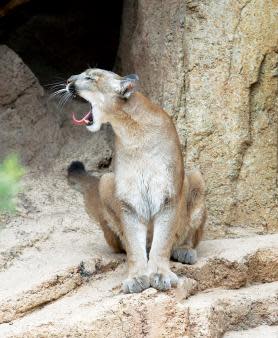Wildlife Viewing
We've all had it happen. You look up from the trail just in time to see an animal dive out of sight - a swoop of wings, a flash of antler, a rustle of brush. The truth is, most animals see, hear and smell us long before we see them. Depending on how far away we are and how we act, they decide whether to stay, defend themselves, or flee.
With the right combination of patience and know-how, you will greatly increase your chances of viewing desert creatures in their natural habitat. Follow these tips for a rewarding wildlife viewing adventure.
Bird Watching
There are over 500 species of birds just waiting to be spotted in the Tucson area.
Animal Safety
While enjoying our wonderful Sonoran desert, be aware that some of our desert creatures are best viewed from a distance. Below you will find some tips in case you encounter one of these unique critters.

photo: Rhonda Spencer
Mountain Lion
Realistically, the odds of encountering a mountain lion and being attacked are slim. But as long as the possibility exists, it can't hurt to take some precautions. Dawn, dusk and evening hours are prime activity times for lions, so avoid activities or be extra cautious then, and follow these tips:
Do not approach a lion! Back away slowly, and watch for signs that it may attack. (Often these are similar to their domestic distant cousin, your house cat.) Do not run from a lion; that is acting like prey, and an invitation to chase. Make yourself appear larger by opening a jacket, raising your arms, and speak loudly and slowly. Do not bend over or crouch down. Throw rocks or sticks to discourage predatory behavior.
Rattlesnake
During the months of April through October, you have a good chance of seeing a rattlesnake. They are most active in evening and morning hours when temperatures are warmest. Give them room. For the most part, the rattlesnakes in Southern Arizona are defensive, not aggressive, and won't strike unless provoked, but remember these tips:
Watch where you put your feet. If you are really unlucky and do get bitten, go to an emergency room as soon as possible. Not every snake bite transfers venom, but you should not try to treat the bite yourself.
"I’ll tell you what, my friends, southern Arizona is full of “Behold!” moments of wild plants and wild animals. Behold, my friends the desert is beautiful, oh yeah it is."
Scorpion
Scorpions are nocturnal or diurnal and are usually active if nighttime temperatures are above 70-degrees F. They are predatory animals that feed on a variety of insects, spiders, centipedes, and other scorpions. Only a few species of scorpions in Southern Arizona have a poisonous sting, and for a healthy adult, the sting is painful but not life threatening.
Tarantula
Tarantulas spend most of their time in underground burrows, but during the summer, the males emerge after dark, looking for females.
Don't handle tarantulas: Tarantulas have large fangs, but are not aggressive to humans and will only bite if handled improperly. Their bites are painful, but not dangerous, since Arizona's tarantulas are only mildly venomous. They also have special, loosely-attached, highly irritating, urticating hairs on the top of the abdomen which they can release in a small cloud if threatened. This can cause severe irritation to the mucous membranes of any mammal.

Gila Monster
The Gila Monster is a stout-bodied lizard that grows 18 to 24 inches in length. It has black, orange, pink or yellow broken blotches, bars and spots, with bands extending onto its blunt tail. Its face is black, and it has small, bead-like scales across its back. They are shy and only get above ground a couple of weeks a year.
Don't handle Gila Monsters: Bites are rare, but once they latch on it's hard to make them let go, and they are venomous.
Javelina
A pig-like animal (but not a pig; it's a collared peccary). Left alone, they are harmless and afraid of humans, but if they have to defend themselves they can be fierce. If you see a herd or an individual, watch but don't try to get closer.
Camera Tips
- Use at least a 400 mm lens.
- Have the sun at your back.
- Afternoon light is best.
- Aim for featuring wildlife with natural surroundings, not a full-frame profile.
Wildlife Viewing Tips
Blend in: Wear natural colors and unscented lotions, crouch behind boulders or vegetation to hide your figure, and walk slowly and softly so you don't snap twigs.
Don't appear to be a threat: relax your muscles (animals can easily detect tension); avert your gaze (animals may interpret a direct stare as a threat); and never walk directly toward an animal, take a roundabout route instead.
Respect animals' natural behaviors: Don't try to "save" baby animals (mom is usually nearby); don't share your food, it may harm their digestive systems or get them hooked on handouts; and resist the urge to throw a rock to see a flock fly.
Expand your senses: Switch your gaze from the foreground to a panoramic view and back again; use your peripheral vision instead of turning your head; look for out-of-place shapes -(horizontal shapes in a mostly vertical space or an oblong shape on a tree branch); look above and below you; and listen (silence can speak volumes, animals may fall silent when a predator is passing through the area).







